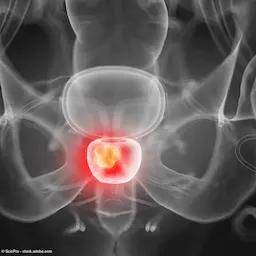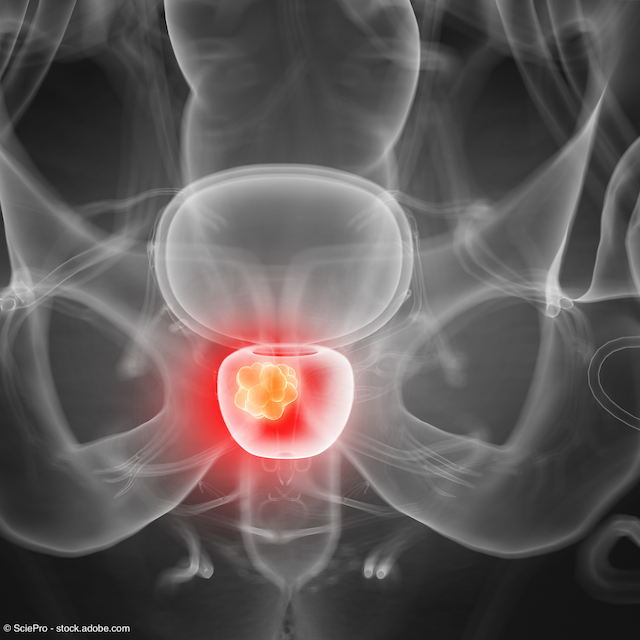News
Article
Studies show low urinary bladder interference on flotufolastat F 18 scans
Author(s):
“The ability to gather actionable information from PSMA PET scans is important for physicians to make informed decisions about patient management for men with prostate cancer,” says Eugene Teoh, MBBS, MRCP, FRCR, DPhil.
Data presented at the Society of Nuclear Medicine and Molecular Imaging (SNMMI) Annual Meeting show that accurate image interpretation of flotufolastat F 18 (Posluma) PET/CT scans is significantly less impeded by urinary bladder activity compared with 68Ga-PSMA-11-PET, with furosemide able to further augment disease detection.1
The data presented at SNMMI add to data from a post-hoc analysis of phase 3 data on flotufolastat F 18.

Flotufolastat F 18 received FDA approval in May 2023 for PET imaging of PSMA-positive lesions in patients with prostate cancer with suspected metastasis who are candidates for initial definitive therapy or with suspected recurrence based on an elevated serum prostate-specific antigen (PSA) level.
“The ability to gather actionable information from PSMA PET scans is important for physicians to make informed decisions about patient management for men with prostate cancer,” said Eugene Teoh, MBBS, MRCP, FRCR, DPhil, chief medical officer of Blue Earth Diagnostics, in a news release on the studies.1 “Activity in the urinary tract, especially in the urinary bladder, is a common feature of FDA-approved PSMA-PET radiopharmaceuticals which are excreted via the urine. High urinary activity can potentially obscure tumors in the prostate region and regional lymph nodes in the pelvis, which are common sites of recurrence, and interfere with accurate image interpretation.”
Bladder activity parameters with flotufolastat F 18 vs 68Ga-PSMA-11-PET
The first study compared urinary activity between flotufolastat F 18 vs 68Ga-PSMA-11-PET in a matched cohort of patients with prostate cancer, showing that image interpretation with flotufolastat F 18 was significantly less impacted by urinary activity vs 68Ga-PSMA-11-PET.2 In total, each cohort included 62 patients with prostate cancer.
Overall interference from bladder activity was rated as 0, 1, and 2 among 47, 10, and 5 patients with 68Ga-PSMA-11-PET compared with 60, 2, and 0 patients with flotufolastat F 18, respectively (P = .0006). 68Ga-PSMA-11-PET also demonstrated a median semi-quantitative bladder activity score of 2, compared with a median score of 0 for flotufolastat F 18.
Additionally, 3 (18%) of 17 of the 68Ga-PSMA-11 primary tumors located near the bladder were obscured by radioactivity in the bladder, vs 0 of 24 of the flotufolastat F 18 lesions. Ureter retention was present in 13/62 (21%) and 0/62 (0%) of 68Ga-PSMA-11-PET and flotufolastat F 18 PET scans, respectively.
68Ga-PSMA-11-PET demonstrated a median SUVmax of 7.4 in the bladder compared with 3.3 with flotufolastat F 18 PET (P < .0001). The median SUVmax in the primary tumor was 14.7 and 19.7 for 68Ga-PSMA-11-PET and flotufolastat F 18 PET, respectively (P = .1338). 68Ga-PSMA-11-PET also demonstrated a significantly lower tumor-to-bladder ratio vs flotufolastat F 18 PET (P < .0001).
Use of furosemide
The second study (NCT05779943) presented at SNMMI assessed the impact of forced diuresis with furosemide to further improve bladder activity and detect biochemical recurrence of prostate cancer in the prostate bed region during flotufolastat F 18 PET/CT imaging.3
Overall, the investigators found that use of furosemide was safe and feasible during flotufolastat F 18 PET/CT imaging, with furosemide leading to further reductions in bladder activity as well as increased detection of biochemical recurrence of prostate cancer in the prostate bed region. In total, the interim analysis included PET/CT scans both with and without furosemide from 12 men with prostate cancer.
Specifically, scans with furosemide showed significant reductions in bladder activity, with a median SUVmax of 4.55 (IQR, 2.85-5.90) compared with 13.85 (IQR, 9.95-25.10) on the scans without furosemide (P = .0022). Further, the median SUVmean was 3.00 (IQR, 2.00-4.45) on the scans with furosemide vs 9.7 (IQR, 6.2-21.45) on the scans without furosemide (P = .0022).
Similarly, bladder volume was shown to be higher on the scans with furosemide, with a volume of 361.85 mL (IQR, 161.05-451.50) vs 68.7 mL (IQR, 49.00-182.25) on the scans without furosemide, though the difference was not statistically significant (P = .0719).
In detecting recurrence, 11 of 12 scans with furosemide were positive for prostate cancer recurrence vs 7 of 12 scans without furosemide (P = .0593). Further, prostate cancer recurrence in the prostate bed region was detected in 10 of 12 scans with furosemide compared with 5 of 12 scans without furosemide (P = .0350).
The scans with and without furosemide were comparable regarding both the SUVmax of the prostate bed region recurrent lesions (6.20 vs 5.65; P = .9362) and the prostate cancer recurrence localization to the pelvic and extra-pelvic regions.
Overall, the authors concluded, “Furosemide-augmented bladder activity reduction is safe and feasible for 18F-flotufolastat PET/CT imaging, achieving further reduction in bladder activity. While detection rates for without-furosemide are broadly consistent with phase 3 studies, [prostate bed region] recurrence detection is further increased with furosemide with no impact on the radiotracer avidity in the recurrent lesion.”
Additional data on flotufolastat F 18
The data presented at the SNMMI Annual Meeting further complement data from a post-hoc analysis of phase 3 data on flotufolastat F 18, which showed that the agent demonstrated a relatively low urinary bladder interference that did not impact disease assessment.4
“A post-hoc analysis of our phase 3 clinical trials demonstrated that 96% of patients (682/712) exhibited either no urinary activity or activity that was easily distinguishable from disease,” Teoh added in the news release.1 “Although furosemide usage has been widely described for other PSMA PET imaging agents as a potential means to reduce urinary activity, the Posluma phase 3 trial results were achieved without its use. In cases from this Emory study where furosemide was not used, results also demonstrate the high Posluma detection rates in patients with low PSA levels as observed in prior Blue Earth Diagnostics clinical trials.”1
References
1. Blue Earth Diagnostics highlights results of studies evaluating impact of urinary activity on image interpretation and performance of POSLUMA (flotufolastat F 18) and 18F-flotufolastat PET in prostate cancer. News release. Blue Earth Diagnostics. June 10, 2024. Accessed June 11, 2024. https://www.biospace.com/article/releases/blue-earth-diagnostics-highlights-results-of-studies-evaluating-impact-of-urinary-activity-on-image-interpretation-and-performance-of-posluma-flotufolastat-f-18-and-18f-flotufolastat-pet-in-prostate-cancer/
2. Rauscher I, Langbein T, Fuetterer CS, et al. Evaluation of qualitative and quantitative PET parameters in primary prostate cancer patients: double-match comparison of 18F-flotufolastat- and 68Ga-PSMA-11-PET. Presented at: Society of Nuclear Medicine and Molecular Imaging (SNMMI) Annual Meeting. June 8-11, 2024. Toronto, Canada
3. Lawal I, Mushtaq A, Jani AB, et al. Impact of forced diuresis with furosemide in the evaluation of biochemical recurrence of prostate cancer with 18F-rhPSMA 7.3 PET/CT: Interim analysis of an ongoing prospective trial. Presented at: Society of Nuclear Medicine and Molecular Imaging (SNMMI) Annual Meeting. June 8-11, 2024. Toronto, Canada
4. Kuo P, Hermsen R, Penny R, Postema E. Post-hoc analysis of the LIGHTHOUSE and SPOTLIGHT studies to assess the impact of urinary activity on interpretation of 18F-rhPSMA-7.3 PET/CT. J Nucl Med. 2023;64 (suppl 1). https://jnm.snmjournals.org/content/64/supplement_1/P52














